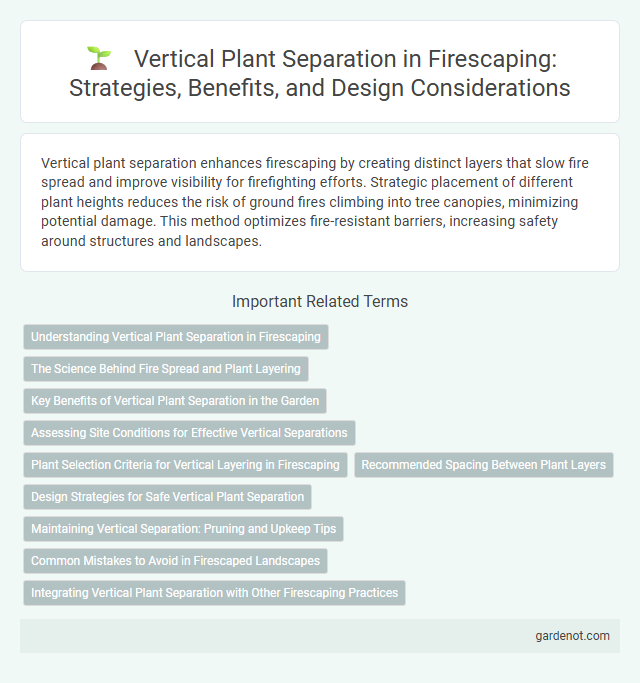Vertical plant separation enhances firescaping by creating distinct layers that slow fire spread and improve visibility for firefighting efforts. Strategic placement of different plant heights reduces the risk of ground fires climbing into tree canopies, minimizing potential damage. This method optimizes fire-resistant barriers, increasing safety around structures and landscapes.
Understanding Vertical Plant Separation in Firescaping
Vertical plant separation in firescaping minimizes wildfire risk by creating clear spacing between plant layers, such as ground covers, shrubs, and trees. This technique interrupts the continuous fuel ladder that allows fire to climb from low vegetation to higher branches, reducing fire intensity and spread. Proper vertical separation integrates fire-resistant plant selections and strategic pruning to enhance landscape safety.
The Science Behind Fire Spread and Plant Layering
Vertical plant separation plays a crucial role in firescaping by disrupting the continuous fuel ladder that facilitates fire spread from ground to canopy. Scientific studies reveal that increased vertical distance between vegetation layers reduces flame transfer, limiting fire intensity and promoting safer landscapes. Effective plant layering combines strategic spacing and selection of fire-resistant species to create natural firebreaks and enhance overall wildfire resilience.
Key Benefits of Vertical Plant Separation in the Garden
Vertical plant separation maximizes garden space by allowing diverse plant species to thrive in layered environments, enhancing biodiversity and visual appeal. This method improves plant health through better air circulation and sunlight exposure, reducing disease risk and promoting robust growth. Efficient water usage and maintenance are achieved, as vertical separation facilitates targeted irrigation and easier access for care.
Assessing Site Conditions for Effective Vertical Separations
Assessing site conditions for effective vertical plant separation involves analyzing soil type, slope, and microclimate to determine optimal plant placement. Proper evaluation of sunlight exposure and moisture levels ensures distinct vegetation layers that reduce wildfire fuel continuity. Integrating vertical separation strategies enhances fire resilience by disrupting fire spread through varied plant heights.
Plant Selection Criteria for Vertical Layering in Firescaping
Plant selection criteria for vertical layering in firescaping emphasize fire-resistant species with high moisture content to reduce flammability. Native plants adapted to the local climate and soil conditions enhance resilience and support natural firebreaks. Strategic layering involves combining ground covers, shrubs, and small trees to create vertical separation that slows fire spread and improves safety.
Recommended Spacing Between Plant Layers
Recommended spacing between plant layers in firescaping is crucial to minimize fire risk and enhance landscape resilience. Maintaining at least 18 to 36 inches of vertical separation between low, medium, and tall vegetation layers prevents flame transfer and reduces heat intensity. Proper vertical plant separation promotes defensible space by interrupting fire ladders and slowing wildfire spread around structures.
Design Strategies for Safe Vertical Plant Separation
Effective design strategies for safe vertical plant separation include using fire-resistant barriers and incorporating non-flammable landscaping materials between plant layers to minimize fire spread. Maintaining adequate vertical clearance by pruning lower branches and selecting low-flammability plants can prevent flames from climbing. Integrating these techniques with proper spacing and plant density ensures safer firescaping in urban and wildland interface areas.
Maintaining Vertical Separation: Pruning and Upkeep Tips
Maintaining vertical plant separation involves regular pruning to prevent overcrowding and ensure adequate airflow, which reduces disease risk and promotes healthy growth. Strategic trimming maintains clear boundaries between plant layers, enhancing sunlight penetration and root development. Consistent upkeep through removal of dead or excess foliage supports optimal fire-resistant landscaping within a firescaping framework.
Common Mistakes to Avoid in Firescaped Landscapes
Incorrect plant spacing and ignoring fire-resistant species are common mistakes in vertical firescaping, increasing fire risk by allowing flames to ladder upward. Overlooking the removal of dead or dry vegetation from vertical layers adds combustible material that fuels fire spread. Failing to create adequate vertical clearance between plants and structures compromises defensible space, undermining fire mitigation efforts.
Integrating Vertical Plant Separation with Other Firescaping Practices
Integrating vertical plant separation with other firescaping practices enhances fire resilience by creating strategic breaks between vegetation layers, reducing fuel continuity and fire intensity. Combining vertical separation with horizontal fuel breaks, defensible space, and fire-resistant plant selection optimizes landscape safety and mitigates wildfire spread. Proper maintenance of vertical gaps alongside routine pruning and clearing supports effective fire management in fire-prone environments.
Vertical plant separation Infographic

 gardenot.com
gardenot.com